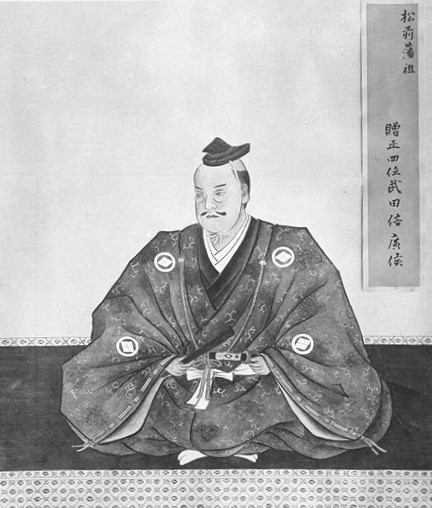Takeda Nobuhiro on:
[Wikipedia]
[Google]
[Amazon]
 Takeda Nobuhiro (武田 信広), also known as Kakizaki Nobuhiro (蠣崎 信廣) (1431 – 1494) was the ancestor of the
Takeda Nobuhiro (武田 信広), also known as Kakizaki Nobuhiro (蠣崎 信廣) (1431 – 1494) was the ancestor of the
 Takeda Nobuhiro (武田 信広), also known as Kakizaki Nobuhiro (蠣崎 信廣) (1431 – 1494) was the ancestor of the
Takeda Nobuhiro (武田 信広), also known as Kakizaki Nobuhiro (蠣崎 信廣) (1431 – 1494) was the ancestor of the Matsumae clan
The was a Japanese clan that was confirmed in the possession of the area around Matsumae, Hokkaidō as a march fief in 1590 by Toyotomi Hideyoshi, and charged with defending it, and by extension the whole of Japan, from the Ainu "barbarians" ...
, and is celebrated for his role in suppressing the 1457 Ainu revolt of Koshamain. The adopted son of Takeda Nobukata, ''shugo
, commonly translated as “(military) governor,” “protector,” or “constable,” was a title given to certain officials in feudal Japan. They were each appointed by the ''shōgun'' to oversee one or more of the provinces of Japan. The pos ...
'' (Governor) of Wakasa Province
was a province of Japan in the area that is today the southwestern portion of Fukui Prefecture in the Hokuriku region of Japan. Nussbaum, Louis-Frédéric. (2005). "''Wakasa''" in . Wakasa bordered on Echizen, Ōmi, Tanba, Tango, and Yama ...
, he was later re-adopted by Kakizaki Sueshige. Some sources say he was originally of the Minabe clan.
Life
Nobuhiro was born in Aoi castle inObama
Barack Hussein Obama II ( ; born August 4, 1961) is an American politician who served as the 44th president of the United States from 2009 to 2017. A member of the Democratic Party (United States), Democratic Party, Obama was the first Af ...
, the capital of Wakasa province, and was called Hikotarō as a child. Though he was the older child, he was passed over as his father's heir for his younger brother Takeda Kuninobu, who had already himself produced a son. Nobuhiro was said to have been adopted, not a true blood relative, and became estranged from the family.
At the age of 21, he escaped Wakasa in the middle of the night, along with Takeda vassals Sasaki Shigetsuna, Kudō Sukenaga and three others. They made their way towards the shogunal residence, but found that Minabe Mitsumasa
file:Minabe townhall001.JPG, 270px, Minabe Town Hall
is a small List of towns in Japan, town located in Hidaka District, Wakayama, Hidaka District, Wakayama Prefecture in the Kansai region of Japan. , the town had an estimated population of 12,137 ...
had left. Moving to the territory of the Kakizaki clan
The was a Japanese clan that was confirmed in the possession of the area around Matsumae, Hokkaidō as a march fief in 1590 by Toyotomi Hideyoshi, and charged with defending it, and by extension the whole of Japan, from the Ainu "barbarians" ...
, Nobuhiro adopted their surname as his own. A few years later, in 1454, he followed Andō Masasue to Hokkaidō (then called Ezo
(also spelled Yezo or Yeso) is the Japanese term historically used to refer to the lands to the north of the Japanese island of Honshu. It included the northern Japanese island of Hokkaido, which changed its name from "Ezo" to "Hokkaidō" in 18 ...
), and settled in the town of Kaminokuni. There, he came to be adopted by Kakizaki Sueshige, who named Nobuhiro his heir. Two years later, he sired a son named Kakizaki Mitsuhiro Kakizaki may refer to:
*Kakizaki (surname) Kakizaki (written: 柿崎 or 蠣崎) is a Japanese surname. Notable people with the surname include:
*, Japanese samurai
*, Japanese women's basketball player
*, Japanese artist, sculptor, and installatio ...
.
One of largest Ainu revolts in history, Koshamain's Revolt, occurred the following year, in 1457. Koshamain led a group of Ainu in a surprise attack on the samurai town, and Nobuhiro led a fierce counterattack along with Kakizaki Sueshige. The tide of battle turned a few times, but the samurai won in the end. Thus, Nobuhiro became one of the more famous and celebrated heroes in the Japanese history of Hokkaidō.
He built Katsuyama castle in 1462, and began to receive tribute from the Ainu of Sakhalin
Sakhalin ( rus, Сахали́н, r=Sakhalín, p=səxɐˈlʲin; ja, 樺太 ''Karafuto''; zh, c=, p=Kùyèdǎo, s=库页岛, t=庫頁島; Manchu: ᠰᠠᡥᠠᠯᡳᠶᠠᠨ, ''Sahaliyan''; Orok: Бугата на̄, ''Bugata nā''; Nivkh ...
in 1475, though there was no possibility of the small number of samurai present effectively extending their control that far.
Nobuhiro died at the age of 64, in 1494. His descendants would continue to defend Japanese settlements in Hokkaidō from the natives. Around the year 1600, the family name was changed to Matsumae, and as the lords of Matsumae Domain
The was a Japanese clan that was confirmed in the possession of the area around Matsumae, Hokkaidō as a march fief in 1590 by Toyotomi Hideyoshi, and charged with defending it, and by extension the whole of Japan, from the Ainu "barbarians" ...
, they headed shogunal relations with (and defense against) the Ainu until the late 19th century.
Hokkaidō was officially annexed following the Meiji Restoration
The , referred to at the time as the , and also known as the Meiji Renovation, Revolution, Regeneration, Reform, or Renewal, was a political event that restored practical imperial rule to Japan in 1868 under Emperor Meiji. Although there were ...
. A few years later, when railroads began to be spread across the island, one of the first locomotives
A locomotive or engine is a rail transport vehicle that provides the motive power for a train. If a locomotive is capable of carrying a payload, it is usually rather referred to as a multiple unit, motor coach, railcar or power car; the ...
was named ''Nobuhiro'' after him.
References
* This article's content is derived from that of the corresponding Japanese Wikipedia article. {{DEFAULTSORT:Takeda, Nobuhiro Samurai Hokkaido region 1431 births 1494 deaths